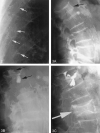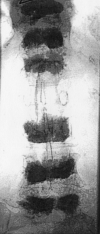Percutaneous vertebroplasty: complication avoidance and technique optimization
- PMID: 13679295
- PMCID: PMC7973982
Percutaneous vertebroplasty: complication avoidance and technique optimization
Figures















Similar articles
-
[Pelvic and leg venous thrombosis as a complication of percutaneous vertebroplasty].Rofo. 2003 Apr;175(4):565-6. doi: 10.1055/s-2003-38437. Rofo. 2003. PMID: 12677514 German. No abstract available.
-
Fluoroscopy-guided percutaneous vertebroplasty for symptomatic loosened pedicle screw and instrumentation-associated vertebral fracture: an evaluation of initial experiences and technical note.J Neurosurg Spine. 2018 Apr;28(4):364-371. doi: 10.3171/2017.7.SPINE17625. Epub 2018 Jan 12. J Neurosurg Spine. 2018. PMID: 29327973
-
Vertebroplasty of the first sacral vertebra.Pain Physician. 2009 May-Jun;12(3):651-7. Pain Physician. 2009. PMID: 19461832
-
Current concepts and techniques in percutaneous vertebroplasty.Orthop Clin North Am. 2006 Jul;37(3):409-34, vii. doi: 10.1016/j.ocl.2006.05.001. Orthop Clin North Am. 2006. PMID: 16846770 Review.
-
Percutaneous vertebroplasty: an update.Semin Ultrasound CT MR. 2005 Apr;26(2):52-64. doi: 10.1053/j.sult.2005.02.002. Semin Ultrasound CT MR. 2005. PMID: 15856807 Review.
Cited by
-
Transpedicle body augmenter in painful osteoporotic compression fractures.Eur Spine J. 2007 May;16(5):589-98. doi: 10.1007/s00586-006-0197-6. Epub 2006 Sep 7. Eur Spine J. 2007. PMID: 16957946 Free PMC article.
-
Image-Guided Bone Consolidation in Oncology.Semin Intervent Radiol. 2018 Oct;35(4):221-228. doi: 10.1055/s-0038-1669468. Epub 2018 Nov 5. Semin Intervent Radiol. 2018. PMID: 30402004 Free PMC article. Review.
-
Current perspectives on percutaneous vertebroplasty: current evidence/controversies, patient selection and assessment, and technique and complications.Radiol Res Pract. 2011;2011:175079. doi: 10.1155/2011/175079. Epub 2011 May 21. Radiol Res Pract. 2011. PMID: 22091375 Free PMC article.
-
Chronic obstructive pulmonary disease (COPD) patients with osteoporotic vertebral compression fractures (OVCFs): improvement of pulmonary function after percutaneous vertebroplasty (VTP).Eur Radiol. 2014 Jul;24(7):1577-85. doi: 10.1007/s00330-014-3165-2. Epub 2014 Apr 18. Eur Radiol. 2014. PMID: 24744201
-
Pulmonary cement embolisation after percutaneous vertebroplasty.BMJ Case Rep. 2023 Feb 2;16(2):e254292. doi: 10.1136/bcr-2022-254292. BMJ Case Rep. 2023. PMID: 36731953 Free PMC article. No abstract available.
References
-
- Deramond H, Depriester C, Galibert P, et al. Percutaneous vertebroplasty with PMMA: technique, indications and results. Radiol Clin North Am 1998;36:533–546 - PubMed
-
- Cotton A, Dewatre F, Cortet B, et al. Percutaneous vertebroplasty for osteolytic metastases and myeloma: effects of the percentage of lesion filling and the leakage of methyl methacrylate at clinical follow-up. Radiology 1996;200:525–530 - PubMed
-
- Kaplan FS, Scherl JD, Wisneski R, et al. The cluster phenomenon in patients who have multiple vertebral compression fractures. Clin Orthop 1993;297:161–167 - PubMed
MeSH terms
Substances
LinkOut - more resources
Full Text Sources
Medical
